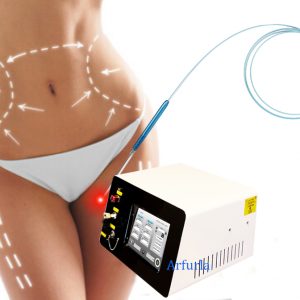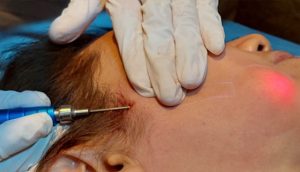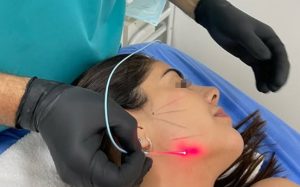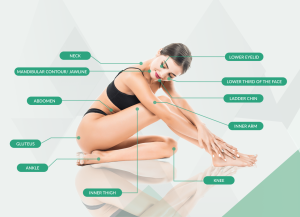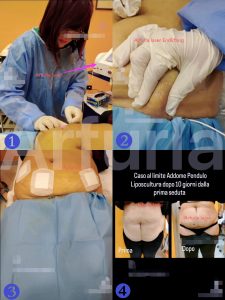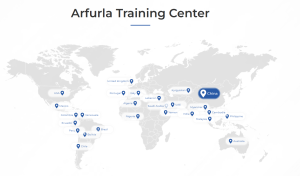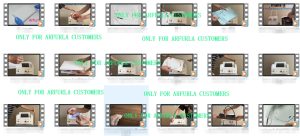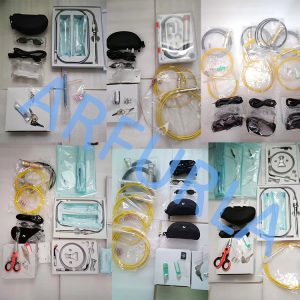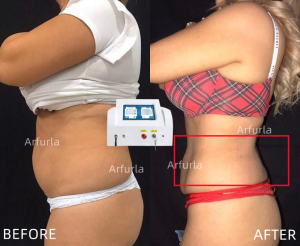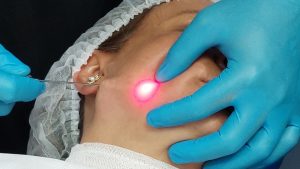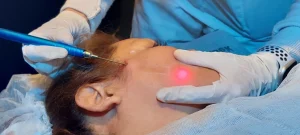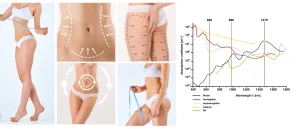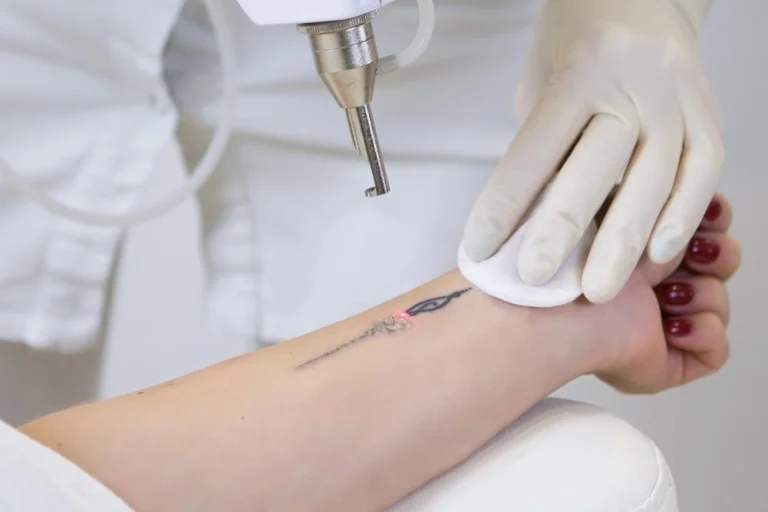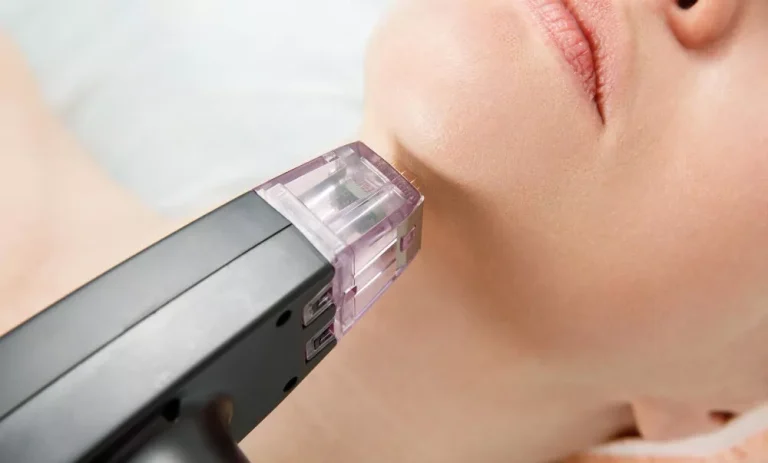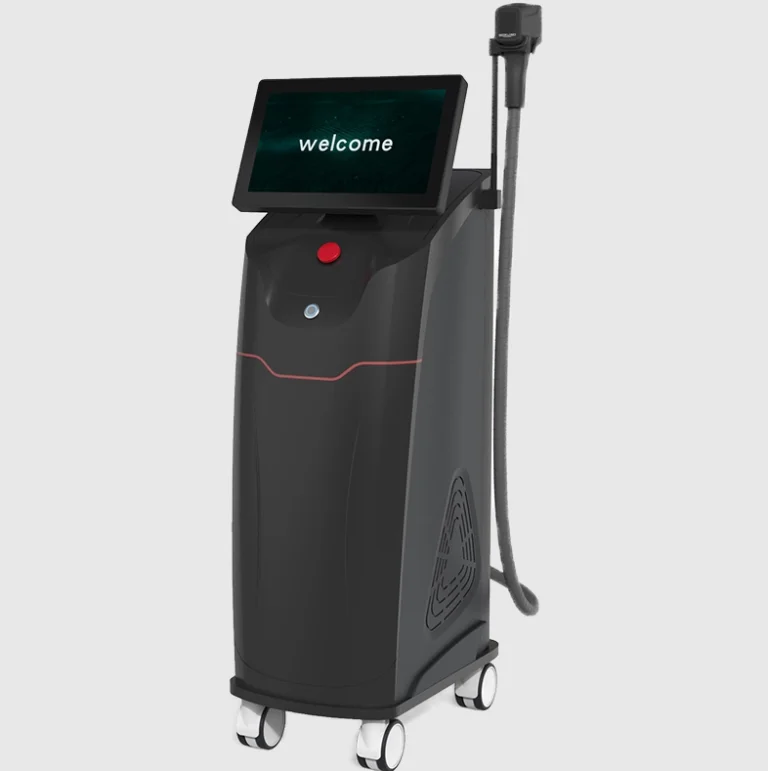980nm 1470nm endolift endolaser for facelift bodylift medical surgery laser lipolysis liposuction equipment 400um fiber
Principle And Efficacy of Laser Lipolysis Liposuction Endolaser
The Arfurla Endolift machine leverages a dual‐wavelength diode laser 980nm & 1470nm delivered via a fiber and cannula to achieve simultaneous subcutaneous fat reduction and skin tightening in a minimally invasive, outpatient setting.
The 980nm wavelength preferentially targets hemoglobin and vascular structures, providing hemostasis and stimulating superficial collagen remodeling, while the 1470nm wavelength is highly absorbed by water in adipose tissue, promoting efficient fat emulsification and deep neocollagenesis. Together, these wavelengths induce selective photothermal damage to adipocytes and connective septa, leading to fat liquefaction, tissue contraction, and new collagen formation, all with minimal downtime and low risk of complications.
Treatment Process of 400um Fiber laser liposuction enolift
1. Fiber Insertion
A 400um-800um optical fiber is inserted through a small skin entry point into the subcutaneous fat layer.
2. Photothermal Fat Liquefaction
The 1470 nm energy selectively heats water-rich fat cells, causing adipocyte rupture and liquefaction.
3. Vascular Coagulation and Hemostasis Simultaneous 980 nm delivery coagulates small vessels, minimizing bleeding and bruising during and after the procedure.
4. Collagen Remodeling
Thermal stimulation from both wavelengths denatures collagen fibers and activates fibroblasts, initiating a wound-healing cascade that produces new, tighter collagen networks. Clinical Benefits
5. Minimally Invasive & Outpatient
Patients undergo treatment under local anesthesia with tiny puncture wounds, resulting in minimal discomfort and rapid return to daily activities.
6. Dual Fat Reduction & Skin Tightening
Unlike single-wavelength lipolysis, the combined effect ensures both volumetric fat loss and sustained tissue retraction.
7. Low Downtime & Side-Effect Profile
Case studies report minimal edema and bruising, with most individuals resuming normal routines within 24–48 hours.
8. Customizable Energy Delivery
Power settings (e.g., 8–10 W continuous mode) can be tailored to anatomical area and tissue density, optimizing safety and efficacy.
9. Cost-Effective & Reproducible
The dual-wavelength platform reduces the need for multiple devices and streamlines training, offering a high-value solution for clinics.
Treatment Area Application:
1. Face: forehead wrinkles, eye bags and dark circles under the eyes, nasolabial folds in the middle of the face, double chins and neck wrinkles in the neck and jaw.
2. Abdomen: reduce abdominal and waist fat (abdominal fat around the trunk), and improve abdominal skin elasticity.
3. Chest: sagging breasts improve chest skin elasticity
4. Legs: eliminate fat in the front, back and inner sides of the thighs, saddle bags (fat accumulation on the outer side of the thighs)
5. Buttocks: eliminate fat in the buttocks and improve the curve of the buttocks
6. Arms: arms (bow tie), improve the upper arm line
Main Steps of Treatment (Preoperative):
- Anesthesia
Choose anesthesia according to the size of the treatment area and the patient’s tolerance.
Small area (such as face): local infiltration anesthesia (injection of tumescent fluid containing lidocaine, which has both analgesic and bleeding-reducing effects).
Large area (such as waist, abdomen, thigh): intravenous sedation anesthesia or general anesthesia (anesthesiologist cooperation is required) to ensure that the patient is painless during the operation
- Incision (minimally invasive incision)
Make a tiny incision of 1-3 mm (similar to the size of a needle tip) at the marked needle insertion point. The location is usually selected in a hidden place (such as abdominal folds, inner thighs) to avoid postoperative scars.
- Setting parameters
The doctor adjusts the energy intensity, wavelength, action time and other parameters of the laser device according to the preoperative fat detection results (fat thickness, layer) (for example, higher energy may be selected for deep fat, and lower energy for shallow fat to avoid burning the skin).
- Laser lipolysis
Insert the laser fiber probe into the subcutaneous fat layer through the incision and move slowly along the preoperative marked range.
Laser energy acts on fat cells through thermal effects: destroying the fat cell membrane, liquefying the fat cells (turning into liquid fat), and stimulating collagen contraction to help tighten the skin.
- Removing liquefied fat
After laser action, liquefied fat can be discharged in two ways:
Small dose liquefied fat: gradually absorbed through the body’s own metabolism (suitable for small-scale treatment).
Large dose liquefied fat: insert a negative pressure suction tube through the incision to gently suck out the liquefied fat (similar to minimally invasive liposuction), reducing postoperative swelling and recovery time.
Postoperative Attention:
- Immediate care and observation
Wound treatment: Clean and disinfect the treatment area. If there is a minor wound, apply antibiotic ointment and then apply pressure with sterile dressings or elastic bandages to reduce bleeding, swelling and bruising.
- Vital sign monitoring
Observe the patient’s vital signs such as blood pressure and heart rate, as well as postoperative reactions, and confirm that there are no abnormal conditions such as dizziness, nausea, and allergies.
- Postoperative medical advice and guidance
Medication guidance: Prescribe antibiotics (to prevent infection), analgesics (if necessary), anti-edema drugs, etc., and inform the specific usage and dosage.
Key points of care:
Emphasis on keeping the treatment area dry and clean, avoid water (minor wounds need to wait until the stitches are removed or scabs form) to prevent infection.
Arfurla Training and service:
Dear customers, when you purchase our Arfurla Endolift device, you can enjoy our thoughtful training service.
If you prefer self-study, we will provide you with detailed video training materials free of charge. These videos are rich and comprehensive, from the basic operation of the device, parameter settings, to the correct techniques and directions for fat treatment with the Endolift device, with detailed explanations, so that you can learn repeatedly at your own pace and master the key points of device operation. Before you receive the laser device, we will send you the complete treatment training video so that you can familiarize yourself with the operation process in advance.
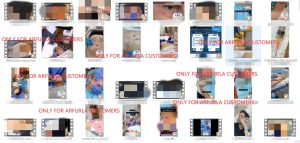

If you prefer on-site guidance, we can introduce you to local experienced professional doctors for paid training services. These doctors have profound attainments and a lot of practical experience in related fields. They will conduct on-site training through theoretical explanations, on-site demonstrations and hands-on guidance, covering detailed operating instructions and practical exercises, to ensure that you can fully and deeply master the operation skills and clinical applications of the Endolift device, helping you quickly put the device into professional medical beauty services.
In addition, we also provide you with a 2-year free warranty service and lifetime maintenance support. When you receive the machine, it also comes with a user manual, maintenance manual, and training CD to guide you in operating the device. Whether it is video training, manual instructions, or online services, we are committed to making it easy and proficient for you to operate the Endolift device and empower your medical aesthetics business.
Comparison of Laser Lipolysis and Traditional Liposuction
- Principle and operation method
Traditional liposuction
Principle: The fat cells are broken and sucked out by physical means. Usually, a lipolytic agent and a swelling fluid (containing anesthetics and vasoconstrictor drugs) are injected into the fat layer first, and then a metal liposuction tube is inserted into the fat layer, and the fat is sucked out by a liposuction machine.
Scope of application: Suitable for large-area fat accumulation (such as abdomen, thighs, buttocks, etc.).
Laser lipolysis
Principle: Use laser fiber to penetrate the skin, emit laser energy of a specific wavelength to dissolve the fat cell membrane, liquefy (emulsify) the fat, and then discharge it through slight negative pressure or natural metabolism. Use laser fiber equipment to stimulate collagen proliferation at the same time.
Scope of application: Applicable to the whole range, melting fat and tightening the skin at the same time.
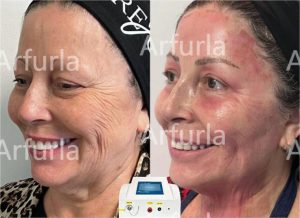
- Trauma and recovery period
Traditional liposuction
Great trauma: A larger incision is required to insert the liposuction tube, which may damage blood vessels and nerves, and bruises and swelling are obvious after the operation.
Long recovery period: You need to wear a body shaper for 1-3 months, and it takes 3-6 months to fully recover.
Laser lipolysis
Minimally invasive: The diameter of the optical fiber is only 1-2 mm, the wound is small (like a pinhole), there is little bleeding, and the swelling is light.
Quick recovery: You can move around after the treatment, and the effect is immediate. Usually the effect is better after 1-3 months.
3. Effect
Traditional liposuction
Significant effect: a large amount of fat can be removed in one session (suitable for those who are obese or need significant body shaping).
Limitations: limited improvement on skin sagging, need to be combined with other skin tightening treatments.
Laser lipolysis
Fine body shaping: suitable for local stubborn fat, and laser heat energy stimulates collagen, melts fat and has a certain skin tightening effect.
- Risks and side effects
Traditional liposuction
Higher risk: unevenness, hematoma, infection, and in severe cases, fat embolism may occur.
Laser lipolysis
Lower risk: However, the skin may be burned by the heat of the laser (rarely), or there may be temporary numbness after the operation.
FAQ
- Is it painful?
During the treatment: Since laser lipolysis uses local anesthesia, most patients only feel a slight warmth or tingling sensation, and the pain is low. Short-term redness, slight bruising or tingling may occur after the operation, which usually subsides within a few hours to a few days.
2. How long does a treatment take?
A single treatment usually takes 20-60 minutes, depending on the size of the treatment area. For example, if the face has less fat, the treatment time is very short, while areas with more fat, such as the abdomen and thighs, require a relatively long treatment time. At the same time, the machine’s wavelength, energy and other related settings will also affect the treatment time.
No recovery period: You can resume normal activities after treatment without hospitalization.
3. How many treatments are needed?
Recommended number of times: 1-3 times, depending on the thickness of the fat and the effect you are looking for.
Interval time: 4-6 weeks between each treatment to ensure fat metabolism and skin recovery.
4. How long will it take to see the effect?
Initial effect: The effect can be seen after the first treatment. The fat layer gradually decreases after about 6-12 weeks, and the best effect is usually seen around 12 to 24 weeks.
Metabolic process: The fat cells destroyed by the laser will be naturally discharged through the lymphatic system.
5. How long can the effect last?
The effect can last for several years, and the destroyed fat cells will be permanently eliminated, but if the weight increases, the remaining fat cells may still expand. And natural aging will continue. In order to maintain the effect, it is recommended that you cooperate with a healthy diet and exercise to avoid fat re-accumulation.
6. Advantages of Endoliting/lipolysis
Minimally invasive: Only a small incision of 1-2mm is required, and the scar is not obvious.
Skin tightening: Laser stimulates collagen regeneration and improves skin sagging.
Fast recovery: less bleeding and mild bruising.
Good effect: long maintenance time, the destroyed fat cells will be permanently eliminated.
7. Suitable for people
– Local fat is stubborn such as abdomen, thighs, double chin.
-People with normal BMI who need body shaping (non-obese people).
-People who want to avoid traditional liposuction.
8. The following are not suitable for this treatment
Pregnant or breastfeeding women, people with severe cardiovascular disease, immune system disease or skin infection.
Patients who have recently used photosensitive drugs such as A acid, antibiotics, and have open wounds or tattoos in the treatment area,
9. Risks and side effects
Common side effects:
Patients may experience temporary redness, bruising or numbness after surgery. A few people may have uneven skin or slight burns, which is mainly related to the doctor’s technical operation. A very small number of people will experience pigmentation, especially those with dark skin should choose this treatment with caution.

